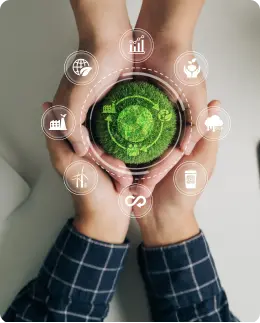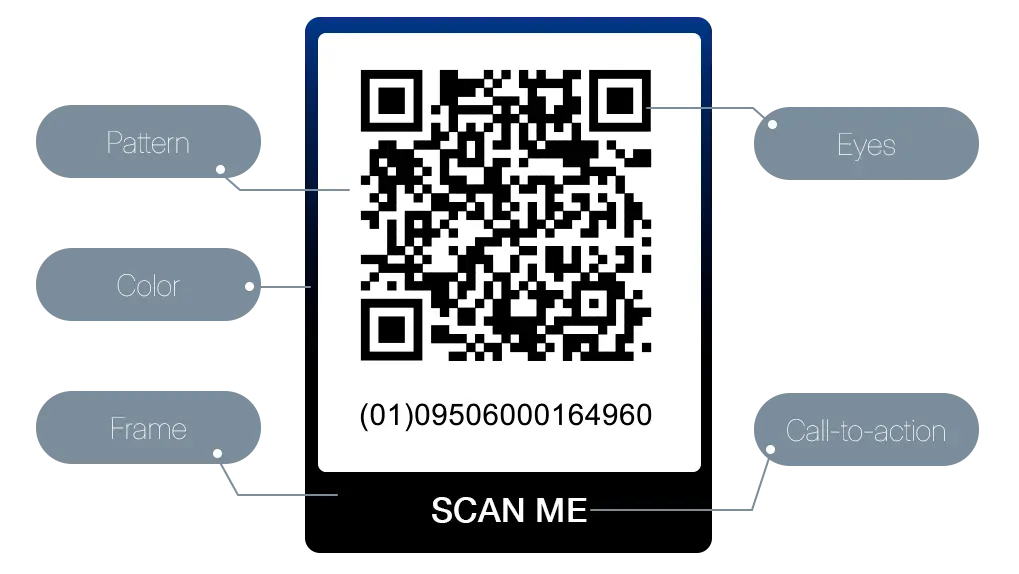De meest geavanceerd.
GS1 QR-codegenerator
Maak een GS1 Digital Link QR-code.
1D-streepjescode + QR-code in één
Waarom een 2D-barcodes gebruiken?
Verbeterde inventaris- en productbeheer

Duurzaamheid

Product authenticatie

Branding en marketing

- Genereren
- Aanpassen
- Duurzaam & kostenbesparend
- Meten
Over GS1 Sunrise 2027
GS1 - een wereldwijd systeem van standaarden met meer dan 100 lidstaten - luidt een nieuw tijdperk in voor de detailhandelsscanning. Tegen het einde van 2027 zullen alle 1D-barcodes worden vervangen door een GS1 Digital Link.Veel Gestelde Vragen
Een GS1 Digital Link QR-code, ook bekend als een 2D-streepjescode, is een geavanceerde streepjescode die fysieke producten verbindt met online informatie met behulp van wereldwijde standaarden. Het verschijnt meestal in een vierkante vorm en bevat informatie over een product - de fabrikant, productdetails, merkinformatie, promotionele inhoud en meer.
Traditionele 1D-barcodes kunnen slechts een beperkte hoeveelheid gegevens bevatten, terwijl GS1 2D-barcodes veel meer informatie kunnen opslaan. 1D-barcodes kunnen worden gelezen met een laser-barcodescanner, terwijl 2D-barcodes kunnen worden gescand met een 2D-scanner of een smartphone.
De GS1 digitale link QR-code is een handige tool voor product identificatie, omdat het alle belangrijke informatie van uw product kan bevatten, zoals:
Gedetailleerde productbeschrijvingen
Productinformatie
Productidentificatienummers
Serienummers
Lotnummers
Vervaldatums
Specificaties en handleidingen
Interactieve inhoud zoals video's en 360° productweergaven
Speciale aanbiedingen en promoties
Duurzaamheidsinformatie en certificeringen
Links naar uw merkwebsite of sociale-mediapagina's
Er zijn tal van voordelen aan het gebruik van GS1 2D barcodes: meer gegevenscapaciteit, betere nauwkeurigheid en de mogelijkheid om een verscheidenheid aan productinformatie toe te voegen. Bedrijven kunnen het gebruiken voor verbeterde klantbetrokkenheid, real-time QR-inhoudsupdates, gestroomlijnde toeleveringsketen en tracking.
Bedrijven moeten bijblijven met geavanceerde technologieën zoals GS1 digitale link en voldoen aan branchenaleving om te voldoen aan de groeiende vraag naar transparantie van informatie, traceerbaarheid van de toeleveringsketen en efficiënte productauthenticatie over systemen.
Om een GS1 QR-codegenerator te maken, heb je een GS1 Bedrijfsprefix nodig. Deze unieke identificatie koppelt je producten aan je bedrijf binnen het GS1 wereldwijde systeem. Vervolgens kun je een door GS1 goedgekeurde oplossingsaanbieder gebruiken om je aangepaste QR-code te genereren en te koppelen aan de gewenste productinformatie.
Het genereren van een GS1 2D-barcod kan kosten met zich meebrengen, afhankelijk van verschillende factoren. Je kunt onze prijzen hier bekijken.
GS1 2D-barcodes zijn meestal groter dan traditionele barcodes. Maar net als standaard QR-codes kan hun grootte variëren afhankelijk van de hoeveelheid opgeslagen gegevens en de afmetingen van het gedrukte materiaal.
Ja, de meeste smartphoneapparaten kunnen GS1 2D-barcodes scannen met behulp van de ingebouwde camera-app.
Nee, je hebt een barcode scanner nodig die in staat is om 2D barcodes te lezen om een GS1 digitale link te scannen. Moderne kassasystemen hebben deze mogelijkheid.
Gezondheidsinstellingen en professionals kunnen deze technologie gebruiken om operationele efficiëntie, producttraceerbaarheid, recall-proces, distributie, patiëntveiligheid en meer te verbeteren. Zo kunnen ziekenhuizen bijvoorbeeld medische apparatuur GS1-barcodes gebruiken om directe gebruikershandleidingen, juiste apparatuurverwijdering, levensduur, onderhoudsinformatie en dergelijke te bieden.
Er zijn meer toepassingen, waaronder:
Productinformatie en verificatie
Product recall management Product terugroepbeheer
Integratie met elektronische patiëntendossiers
Optimaliseer voorraad
De detailhandel kan de door GS1 aangedreven digitale link voor voorraadbeheer gebruiken om de operaties te stroomlijnen en concurrentieel te blijven in de markt of industrie. Bijvoorbeeld, winkeliers kunnen de digitale link gebruiken voor voorraadbeheer om een nauwkeurige en bijgewerkte telling van elk item te hebben.
Andere toepassingen zijn onder andere:
Optimaliseer het afreken- en betalingssysteem.
Product transparantie
Leveranciersketenbeheer
Gegevensanalyse en inzichten, en meer.
Het is ook essentieel voor de productie-industrie om geavanceerde technologie zoals GS1-aangedreven digitale links te gebruiken om bij te blijven met het snel veranderende karakter en de evoluerende eisen van consumenten. Voedselproducenten kunnen GS1 QR-codes voor voedselinformatie gebruiken om meer te weten te komen over het product.
Toepassingen zijn onder andere:
Naadloze productstroom in de wereldwijde toeleveringsketen
Verbeterde kwaliteitscontrole
Stroomlijn productieprocessen.
Wereldhandel en Interoperabiliteit


































